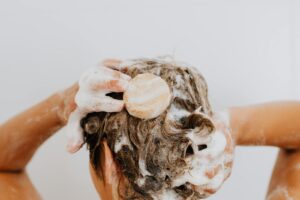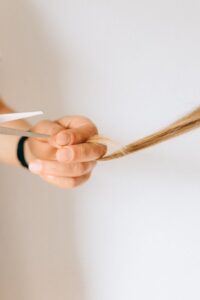Fix Damaged Hair: Repair Dry Hair and Restore Health
At Cameo College, we understand the importance of healthy hair and how it can boost your confidence and overall well-being. If you’re struggling with damaged hair, you’re not alone. Many individuals experience issues with dry or damaged hair due to a variety of factors, and we are here to guide you on how to repair and restore your hair’s health. In this article, we’ll explore the causes of hair damage, how to identify the signs of dry and extremely damaged hair, and what steps you can take to rejuvenate your locks. With proper hair care and a consistent hair care routine, you can achieve smooth, healthy hair once again.
Understanding Damaged Hair

Photo by arwin waworuntu on Pexels
Before we dive into solutions, it’s crucial to understand what damaged hair is and what causes it. Damaged hair can result from a myriad of factors such as overuse of heat styling tools like flat irons and curling irons, frequent hair coloring, and harsh chemical treatments. These practices can weaken the hair shaft and lead to problems such as hair breakage, split ends, and brittle hair. In addition, environmental factors such as sun exposure and pollution can also contribute to hair damage. Understanding these causes helps in taking the right measures to repair damaged hair and protect your hair from further harm.
What Causes Damaged Hair?
The causes of hair damage are often multifaceted. By identifying these causes, you can tailor your hair care routine to prevent further damage and keep your hair feeling healthy and vibrant. Here are some of the primary factors that contribute to hair damage:
- Excessive heat styling without adequate heat protection, such as using a hair dryer frequently or failing to use a heat protectant, can significantly weaken the hair cuticle, leading to dry and brittle hair.
- Chemical processes like dying your hair or repeated use of harsh shampoos and conditioners can strip away the natural oils that keep your hair healthy.
- Environmental factors, including UV rays, humidity, and pollution, can damage your hair over time.
Signs of Dry Hair
Recognizing the signs of dry hair is essential for taking corrective action. Dry hair often feels rough and lacks the smoothness you desire. You might notice that your hair is frizzy, especially in humid conditions, or that it tangles easily. The ends of your hair may appear split and unhealthy, indicating a need for hydration. In some cases, dry hair can also lead to dandruff or an itchy scalp. Paying attention to these signs allows you to intervene early with appropriate hair care products, such as a hydrating hair mask or nourishing hair oil, to restore moisture and repair your hair at home.
Identifying Extremely Damaged Hair
Extremely damaged hair is often characterized by severe breakage and split ends that are difficult to manage. If your hair appears lifeless, lacks luster, and is prone to excessive breakage, it may be time to take serious action. This level of damage often requires a more intensive hair treatment to repair your hair. For those with extremely damaged hair, it is crucial to use a combination of reparative hair care products and possibly a professional hair treatment. Recognizing these signs early on will allow you to take the necessary steps to rejuvenate your hair, ensuring that it grows back healthy and strong.
Effective Ways to Fix Damaged Hair

Photo by Photo By: Kaboompics.com on Pexels
Choosing the Right Shampoo
Choosing the right shampoo is fundamental in your journey to repair damaged hair. At Cameo College, we emphasize the importance of selecting a shampoo that complements your hair type and addresses specific issues, whether it’s dry hair or damaged curly hair. Shampoos enriched with nourishing ingredients help to replenish the natural oils and maintain the health of your hair shaft. Avoid harsh shampoos that strip away moisture, leading to brittle hair and split ends. Instead, look for hydrating formulations that support your hair care routine, providing essential nutrients to repair and protect your hair from further damage. By choosing the right shampoo, you set a solid foundation for achieving healthy hair that feels smooth and resilient.
Utilizing Hair Masks for Repair
Hair masks are a powerful tool in repairing damaged hair, offering intensive nourishment and hydration. At Cameo College, we recommend incorporating a hair mask into your hair care routine to tackle issues such as hair breakage and porous hair. Hair masks work by penetrating deep into the hair cuticle, providing essential moisture and nutrients that help restore your hair’s health. It’s especially beneficial for extremely damaged hair or when you notice signs of frizzy hair. Apply the hair mask to damp hair and allow it to sit for the recommended time, ensuring the ingredients can work effectively to repair your hair. Regular use of hair masks can significantly improve your hair’s texture, making it feel smoother and more manageable.
How to Wash Your Hair Properly
Washing your hair properly is crucial in preventing and repairing hair damage. At Cameo College, we teach the significance of gentle washing techniques to protect your hair and scalp. Begin by thoroughly wetting your hair with lukewarm water to open the cuticles. Apply shampoo and gently massage it into your scalp and hair, focusing on cleansing without causing friction that might lead to breakage. Rinse with cool water to help seal the cuticle, enhancing the shine and smoothness of your hair. When conditioning, focus on the ends of your hair, which are often the most damaged. Proper washing not only keeps your hair healthy but also supports hair growth by maintaining a clean and balanced scalp environment.
Hair Care Tips for Healthy Hair

Photo by Fleur Kaan on Unsplash
Let Your Hair Dry Naturally
At Cameo College, we encourage you to let your hair air dry whenever possible to maintain its natural health and vitality. Frequent use of a hair dryer can cause your hair to become dry or damaged by stripping away moisture and weakening the hair shaft. Allowing your hair to dry naturally minimizes heat exposure, reducing the risk of hair damage and breakage. When your hair is wet, it is more susceptible to damage, so gently pat it with a towel instead of rubbing. This practice helps preserve the integrity of your hair cuticle and keeps your hair feeling smooth and healthy. Embracing air drying as part of your hair care routine is an effective way to protect your hair and enhance its natural texture.
Using Hair Products Wisely
Wisely choosing and using hair care products is essential for maintaining healthy hair. At Cameo College, we advise selecting products that are suitable for your specific hair type and address any particular concerns you may have, such as frizzy hair or damaged curly hair. Opt for shampoos and conditioners that hydrate and nourish the hair without weighing it down. Use a hair mask regularly to provide deep conditioning and repair, especially if you have extremely damaged hair. Heat protectants are crucial if you style your hair with flat irons or curling irons, as they form a protective barrier around the cuticle. By using products thoughtfully, you can prevent further damage and support your hair’s health and growth.
Caring for Different Hair Types
Understanding your hair type is fundamental to developing an effective hair care routine. Different hair types require tailored approaches to keep your hair healthy and vibrant. Here are some tips based on specific hair types:
- For those with coarse hair, focus on hydration and smoothing with products that contain nourishing oils.
- If you have damaged curly hair, ensure your routine includes moisturizing treatments to enhance curl definition and manageability.
Avoid overuse of heat styling tools to prevent damage and hair breakage. Regularly trim the ends of your hair to reduce split ends. By adapting your hair care practices to your specific hair type, you can repair damaged hair and promote healthier, more resilient growth.
Dealing with Split Ends

Photo by Nataliya Vaitkevich on Pexels
Understanding Split Ends
Split ends are a common issue that many individuals with damaged hair face, resulting from the fraying and breaking of the hair shaft. This occurs when the outer layer of your hair, known as the cuticle, becomes damaged and fails to protect the inner layers. Factors such as excessive heat styling, using flat irons and curling irons without proper heat protection, and harsh chemical treatments can exacerbate this problem. Split ends can make your hair appear dull and frizzy, contributing to an overall unhealthy appearance. Understanding the underlying causes of split ends is crucial for taking the necessary steps to prevent further damage and maintain the integrity of your hair.
Preventing Split Ends
Preventing split ends requires a holistic approach to hair care, focusing on both protection and nourishment. Here are some key practices to consider:
- Incorporate a hair mask into your routine to provide deep hydration, helping to repair damaged hair and strengthen the hair shaft.
- Regularly use a heat protectant when styling your hair with heat tools to form a barrier that minimizes heat damage.
- Use a gentle shampoo and conditioner designed for your hair type to maintain moisture and prevent brittleness.
- Trim the ends of your hair regularly to remove split ends and promote healthy growth.
By adopting these practices, you can significantly reduce the occurrence of split ends and keep your hair healthy.
When to Trim Your Hair
Knowing when to trim your hair is key to managing split ends and maintaining hair health. At Cameo College, we advise our students to trim their hair every six to eight weeks to prevent split ends from traveling up the hair shaft and causing further damage. Regular trims help keep your hair looking smooth and healthy, making it easier to manage and style. If you notice increased frizziness, brittle hair, or a lack of shine, it may be time to schedule a trim. By adhering to a consistent trimming schedule, you can ensure your hair remains vibrant and strong, providing a solid foundation for any hair care routine aimed at repairing or preventing damage.

